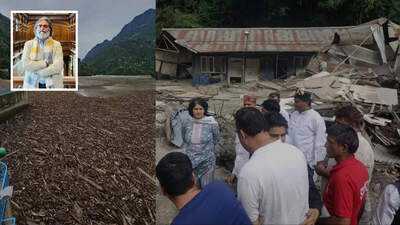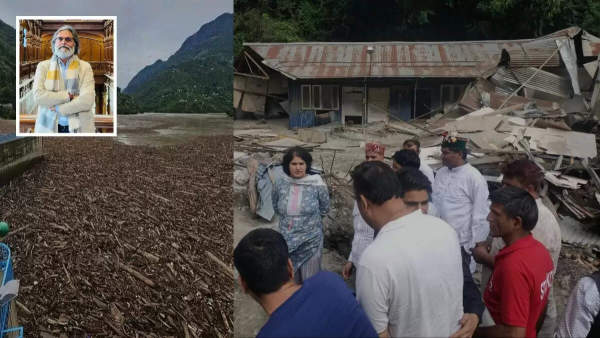
 Devastating Floods Hit Kullu Valley
Devastating Floods Hit Kullu Valley
Kullu, July 1
Heavy rainfall and sudden cloudbursts in Sainj and Gadsa, located in the scenic Kullu valley, have resulted in catastrophic flooding, transforming the landscape. The rivers have overflowed, sweeping away large amounts of timber, reminiscent of the chaotic scenes depicted in the popular film, Pushpa, which has captivated audiences this pre-monsoon season.
In response to the crisis, a portion of the state government has suggested that the logs accumulating in the Pandoh Dam are simply natural debris from the forest, carried downstream by the intense rainfall, rather than evidence of illegal logging. However, local residents are doubtful. Upon examination, the logs appear to have been intentionally cut and stored for a long time, with many being dried and uniformly sized, raising questions about their source. Kuldeep Singh Rathore, an MLA from the ruling Congress Party, has convened a press conference to demand transparency regarding the alleged illegal tree felling and to inquire how such activities could go unnoticed in the valley. Meanwhile, the Conservator of Forests in Kullu and Kehar Singh Khachi, Vice President of the HP State Forest Development Corporation, reported no findings to substantiate claims of illegal logging after their initial inspections.
Government Response and Safety Measures
In the aftermath of the flooding, Kullu's Deputy Commissioner, Torul S. Raveesh, promptly visited the affected areas and issued a critical advisory urging residents and visitors to steer clear of rivers, nallahs, and other dangerous locations. She emphasized the need for careful planning for those intending to travel to the hills during the monsoon season.
On June 26, the Deputy Commissioner returned to the most severely impacted areas, primarily affected by the overflowing Jeeva Nalah due to extreme rainfall and cloudbursts. During her visit, she directed officials to set up temporary shelters for displaced families and ensure immediate financial aid was accessible.
Weather Alerts and Ongoing Risks
Red and Orange Alerts have been issued across multiple districts, including Shimla, Kangra, Mandi, Solan, Sirmaur, Kullu, Chamba, Una, Bilaspur, and Hamirpur, warning of further heavy rainfall and the risk of flash floods, raising alarms for local communities.
Every year, regions like Shimla and Kullu face the relentless wrath of nature. The combination of unregulated construction and the fragile Himalayan ecosystem is increasingly strained, making it harder to withstand the monsoon's fury and other natural calamities.
Local authorities, along with the National Disaster Response Force (NDRF), State Disaster Response Force (SDRF), and Home Guards, are actively conducting rescue operations, assisting stranded individuals, clearing blocked roads, and ensuring essential connectivity remains intact. The threat of additional cloudbursts, flash floods, and landslides is alarmingly high, particularly in areas near rivers, steep slopes, and hydropower projects. The River Beas and its tributaries are experiencing fierce currents due to the continuous downpour, with landslides posing a significant risk to national highways as the monsoon season is just beginning.
Travel Tips for Monsoon Season
Travelers to the Hills Should Consider the Following:
Road Conditions and Forecast
The Kirtapur-Manali NH 21 generally operates smoothly; however, there are several trouble spots, especially at Pandoh, where landslides frequently occur during the rainy season. Travelers should exercise caution at tunnel entrances and exits, as landslides can happen in these areas. From Aut to Kullu, several unstable hills may collapse at any moment. The route from Kullu to Manali also faces disruptions at various points, particularly near Raison, 15 Mile, Kalatah, and close to Manali. In addition to rainfall, traffic congestion can complicate travel conditions. If you are heading towards Sainj or Banjar, be prepared for unexpected challenges. The road to Manikaran, especially around and beyond Kasol, is in poor condition.
Monthly Forecast for July:
According to the India Meteorological Department, the average rainfall across India in July 2025 is expected to be above normal, exceeding 106% of the Long Period Average (LPA). Most regions are likely to experience normal to above-normal rainfall, although parts of Northeast & East India, as well as some areas in extreme South Peninsular India and Northwest India, may receive below-normal rainfall.
Government's Ongoing Efforts
In light of these ongoing challenges, Chief Minister Sukhvinder Singh Sukhu has instructed district officials to remain vigilant around the clock, focusing on early warning systems, distributing relief materials, and executing timely evacuations when necessary.
-
'Rename Teen Hath Naka As Dharmaveer Anand Dighe Saheb': Transport Minister Pratap Sarnaik Pens Thane Metro Line Names Suggestions To Deputy CM Eknath Shinde

-
Video: Indore Long Drive Turns Deadly: 2 Students Die, 3 Critical After Speeding Car Overturns On Indore Bypass

-
Turkey detains cartoonist over Muhammad caricature

-
Pakistan set to assume presidency of UN Security Council

-
Wales incident LIVE: Police close several streets in UK seaside town
